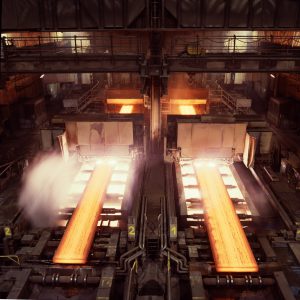-
Steel shop
In the steel shop of ArcelorMittal in Ghent, liquid hot metal coming from the blast furnaces is converted into liquid steel. Due to its chemical composition, liquid hot metal does not possess the required characteristics to be utilised when for instance manufacturing cars or constructing wind turbines and radiators.
How does this work?
 The steel shop consists of two sections:
The steel shop consists of two sections:1. the converter section, where the liquid hot metal is treated and converted into liquid steel.
2. the continuous casting, where the liquid steel is solidified into steel slabs.Converter section
Hot metal is transported to the steel shop where it is, if necessary, first desulphurised. Afterwards the slag, created in the blast furnace and desulphurising process, is removed.
After the desulphurising slag has been removed, the liquid hot metal is poured into the converter on top of accurately weighed quantities of scrap. As steel is endlessly recyclable, scrap can easily be added during the steel making process. This entails that around 15% to 20% of the raw materials needed to create steel, are in fact replaced by recycled scrap.
By means of a water-cooled lance, we now blow pure oxygen onto the liquid hot metal bath. This enables us to remove carbon and other chemical impurities. In order to optimise the refining process, additives (e.g. lime) are also added and nitrogen or argon is injected via the bottom of the converter.
The impure elements are converted into slag, floating on top of the liquid bath, or into gas. The flue gasses are cooled in a boiler and scrubbed in a dust removal installation. Part of this treated converter gas is used in our production departments as an alternative to natural gas, the rest is used to produce electricity in an ENGIE power station nearby.
After having blown oxygen onto the metal bath, the hot metal has become liquid steel. The liquid steel can now be tapped into a steel ladle from where it can be additionally treated:- We can add additional alloys.
- In the steel ladle treatment installation, we can improve the homogeneity of the liquid steel when it comes down to its temperature and composition, which allows us to additionally purify the steel from impurities and inclusions.
- To produce even better deformable types of steel, we can treat it in one of the two RH-vacuum degassing stations. This allows the steel to be profoundly decarbonised, deoxidised in a vacuum and alloyed.
After treatment, the ladle, which can contain up to 295 tonnes of steel, is transported to the casting bay.
Continuous casting
In the continuous casting, liquid steel is solidified into strands which are then cut into slabs.
First the steel ladle is placed into the turret by the casting crane, which is turned 180° to bring the ladle into casting position. By opening the nozzle at the bottom of the steel ladle, the liquid steel flows into an 80 tonnes tundish. The tundish has two tap holes each of them leading to a mould, which determines the size of the steel slabs.
As soon as the nozzle of the ladle is opened, the steel is cast continuously until the ladle is completely empty. Because of the large capacity of the tundish, an empty steel ladle can easily be replaced by a full ladle without interrupting the casting process, this is done by simply turning the turret 180°. That is why this process is referred to as continuous casting.
After leaving the mould, the liquid steel is supported by a series of rolls – grouped into segments – through which it is guided. Large quantities of cooling water are then sprayed upon the liquid steel between the rolls in order to solidify it into a slab. The steel is cast vertically, but is steadily bent horizontally whilst being solidified. The slabs leaving the casting machine are cut to length by natural gas and high-pressure oxygen cutting machines.
We have two continuous casting lines in Ghent. Continuous casting 2, casts slabs with a single width (contrary to slabs with double width like in caster 1), needing no further cutting. The casting width obtained at caster 1 lies between 1,310 and 2,630mm and between 950 and 2,000mm at
caster 2. The strands are always 22cm in thickness and are cut on a maximum slab length of 10.6 meters.
-
Production process
Before
Afterwards


